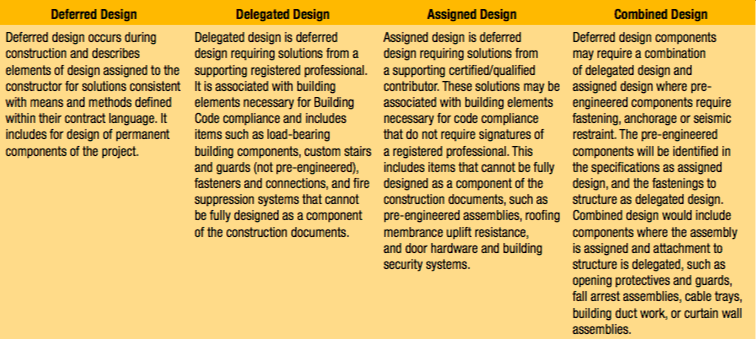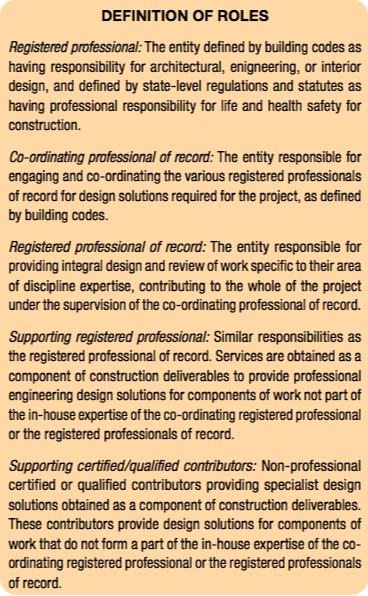By / Keith Robinson, RSW, FCSC, FCSI, Cameron Franchuk, P. Eng, and Gerald Murnane
This article is published in two parts. The first part deals with the identification of issues and concerns in communicating the need for design solutions during construction. The second part deals with different approaches to describing how to manage the deferred design process. Both articles draw attention to the “elephant” in the room and issues causing disruption and disagreements in executing this requirement.
The concepts identified are not new. Complexity of design is driving an increase in the quantity of specifications dealing with the deferred design process. The authors recognize experience of design professionals varies greatly and may be contributing to confusion, misconceptions, and inconsistency for those parties involved with providing design solutions identified by the deferred design process. Recent changes to professional design services and construction procurement have put more pressure on expectations for completeness of construction documentation. Downward pressure on professional fees translates directly to a reduction in design effort to fully describe construction, and consequently, a transfer of responsibility for many design solution to the constructor, essentially delaying or deferring design responsibility to the construction phase of the work.
This deferral of design occurs separately from the production of construction documents and is typically finalized by an entity other than the registered professionals of record (RPR).
The Canadian Construction Association (CCA) recently identified disturbing trends indicating the professional design community in Canada is failing in its responsibility to provide complete and appropriate design solutions to the constructor.
The critical outcome of the CCA recommendations is a need for explicit communication to constructors from the RPR clearly
describing solutions presented within specifications that do not form a part of a firm’s standard services for engineering and design. Full acknowledgement of deferred design components is the responsibility of the RPR.
The CCA identified several reasons leading to the increased number of concerns associated with this practice, including a substantial decrease in design budgets, a lack of appropriate time to complete the design, and a reduction of the specialty design knowledge that does normally form a part of traditional professional design responsibilities.
CCA indicated that the subsequent decrease in quality of documents is not directly related to the quantity of effort to create extensive drawings and specifications from design professionals; rather, it is a problem of the quality of communication within the whole of the construction documents. The association also indicated the use of computers and processes such as building information modelling (BIM) are implicated in the decrease in quality of documentation as users rely on imported information rather than creating project-specific content.
References in this article to Canadian construction groups and concerns for deferred design are similar in the United States.
There is an opportunity for the community of design professionals to take leadership on this issue and to act on necessary improvements to communications with the constructor within documentation by identifying appropriate risk appropriation and managing that risk to the benefit of the project and the owner. Ultimately, this controls exposure to liability arising from the responsibilities of the RPR. The authors believe concepts in this article can establish a standardized national understanding of issues surrounding deferred design and an approach to reduce exposure to risk for design professionals and the construction community.
Collaborative or deferred design?
Collaborative design requires the involvement of a supporting registered professional or supporting certified/qualified contributor for elements of design:
• the RPR does not have in-house;
• required to form a part of the construction documentation; and,
• required to provide a complete solution to the constructor.
Collaborative design can be delivered using design-assist process before bid through pre-qualification or after bid as a cash allowance. (Figure 1).
Design-assist before bid is typically obtained using a request for proposals (RFP) process in which the building elements and components are clearly defined by non-product-specific performance attributes with a stated intent to form a contract with the successful collaborative design-assist partner, and which incorporates a methodology to return to open bidding opportunity if the design solutions process was not beneficial to project outcomes. The process is administered by the design professional and may entail early payment by the owner for design solutions that would otherwise occur during the construction period.
Design-assist after contract award can also be obtained through the RFP process during construction using similar documentation as described for the before-bid process, but administered through a cash allowance to recognize contractual obligation to identify design solutions that are not complete, and that will be determined during the construction period and administered by the constructor.
Deferred design is any design not completed in-house and represents specialist contributions not forming a part of the expertise of the RPR. Deferred design may involve solutions requiring engineering support from a registered professional (delegated-design) or non-engineering solutions from a supporting certified/qualified contributor (assigned-design).
Delegated-design solutions require specific input from a professional engineer retained by the constructor, supplier, fabricator, or manufacturer. They do not require input from a professional engineer. There are components in the deferred design process that may require aspects of delegated- and assigned-design. These must be identified in the documents.
The deferred design process can include aspects of actionable and informational review of submittals, depending on the allocation of delegated-design or assigned-design, and which design profession discipline is involved with the aspect of the review. Deferred design may require the application of multiple submittal review stamps where two or more design professionals are involved with the review.
Managing the design process
Deferred design is completed by supporting registered professionals or supporting certified/qualified contributors who can provide supplementary supporting engineering, knowledgable contributions, or architectural services for components of a defined discipline’s contribution during the construction phase of the project, provided they can submit appropriate assurances of their ability to design these components based on engineering provided by the design professional of record.
Collaborative design is similar in concept to deferred design, but occurs during production of the construction documents, where the supporting registered professionals’ contributions are fully incorporated by the RPR prior to the construction phase.
Building codes allow registered professionals of record to defer or assign design solutions for building components to “others” using appropriate delegation or assignment language through the contractual language and specifications. Transparency by the RPR is required to keep the owner fully informed regarding what design will be performed by themselves and what will be performed by others.
The one limitation under state licensing guidelines is the co- ordinating professional of record and the registered professionals of record are not permitted to defer, delegate, or assign their responsibilities for compliance with the building codes; the responsibility for deferred or collaborative design remains with the co-ordinating professional of record.
Design intent versus design
The phrases “design intent” and “design” are often used synonymously by registered professionals, as if they have the same meaning. Discussions arising from the concepts of deferred design require recognition of two separate functions associated with design intent and design.
Design intent represents the responsibility of registered professionals of record to the public regarding safety, and responsibility for incorporation of functionality and aesthetics described by the owner’s stated performance requirements. Design represents the solution or outcome derived from the design intent. These words are used within this discussion to represent these two aspects and to maintain a clear distinction between the design intent responsibility of the design professional and the design solution responsibility of the contractor.
The players and influencers
Most readers of this magazine are well aware of the traditional roles of constructor (contractor, construction manager, or design- builder) and the architect/engineers (design professional, co- ordination registered professional, or RPR).
The “other design entities” within the arena of professional involvement arising from the deferred or collaborative design process used to deliver deferred submittals during the progress of the work are not defined. Examples of these contributors have already been introduced as the supporting registered professional and the supporting certified/qualified contributors.
Supporting registered professionals are not mandated by the building codes, but delegation of design responsibilities to supporting registered professionals is a recommended mechanism—by most engineering associations—for the RPR to receive assurances from other registered professionals, which do not form a part of the project team and who can provide appropriate design solutions. Various professional associations at the provincial and state levels provide written guidance supporting the role of supporting registered professionals. The term used in this article may not match the definitions of those associations, but the concept of transference and acceptance of responsibilities is clearly described.
The term “supporting certified/qualified contributors” is the “someone else entity” for deferred or collaborative design solutions not requiring participation by a registered professional. This term accounts for contributions from certified or qualified individuals to specialty components or specialist knowledge that does not form a part of the co-ordinating registered professional’s or RPR’s range of experience.
Contributions by the supporting certified/qualified contributors include design services associated with the firestop design covered by a certified fire protection specialist (CFPS) and door hardware schedules and specifications provided by a door and hardware specification consultant (DHSC). This group may also include other certified individuals having specialty knowledge.
State engineering associations only address:
• professional practice;
• how registered professionals respond to design requirements within and outside or provincial borders; and,
• how the RPR incorporates contributions from supporting registered professionals.
The relationship between the RPR and assigned-design contributions by supporting certified/qualified contributors is not specifically described, although the concept is the same as required by the supporting registered professional.
Most architectural associations are silent on the concepts of supporting registered professionals and supporting certified/ qualified contributors. This is the probable reason behind inappropriate or incorrect deferred design within the architectural project documents.
Deferring design must not be used to transfer design intent responsibility to the constructor because the RPR does not have sufficient time or budget to complete the design. Deferring design should only occur when the RPR does not have the necessary skills to complete the work, and the owner is informed and has accepted the need for deferral.
Owners have expectations of the RPR based on the fees paid; an expectation the RPR will provide a complete design, meaning any exclusions to the owner’s stated requirements are clearly identified prior to signing a contract with the owners.
Responsibilities of the constructor
Design intent of temporary facilities has always been the responsibility of the constructor, including any engineering of temporary structures and safety systems not part of the primary building work. This responsibility does not form a part of the deferred design discussion; this is simply work the constructor does as part of their contract deliverables. The design professional may ask to review these design components in an informational submittal, but responsibility stays with the constructor for these components. Engineering of temporary facilities is specifically excluded from the services provided by the RPR under normal contract requirements.
Form of collaborative design
Collaborative design typically occurs during production of the drawings and specifications, but it can occur as a cash allowance component during the construction phase. It is generally incorporated as a component of the information contained within the construction documents, and requires no further delegation of design responsibility to the constructor.
Obtaining design solutions using a design-assist approach without compensation to the supporting certified/qualified contributors or supporting registered professional demeans the value of those services and opens the RPR to scrutiny from peers if the design solutions fail to recognize the complexity of the project.
Collaborative design carries a responsibility for the RPR to maintain a competitive procurement process as well as recognize the professional’s responsibilities to the performance of the building as the co-ordinating professional of record/RPR.
The adage “you get what you pay for” is apt when obtaining design solutions from supporting certified/qualified contributors. The more complex the project requirements, the greater the need to pay for design-assist services.
Design-assist
Collaborative design is identified as design-assist within many specifications prepared by the design community. It is similar in execution to delegated-design and assigned-design with respect to the requirements for letters of commitment and compliance. It is also similar in concept to what some describe as design-build. However, that description associates closely with a contractural condition, and should not be used to describe the actual approach to design-assist used for a project.
Design-assist is a procurement method by which, prior to completion of design, a construction contract may be awarded on a best-value basis, in which a specialty constructor provides design assistance to the design professional of record using a registered professional or supporting certified/qualified contributor retained using a RFP process.
Design-assist can be delivered using the constructor as a procurement entity when working with construction-managed or design-build methods of contract delivery.
Pre-construction design-assist is a fee-for-service approach to design solutions obtainable through a pre-qualified or RFP process. It provides for competitive procurement, with the final design solution forming a part of the construction documentation as either a “single-sourced with no substitutions” specification where design, products, and installation are included as an RFP requirement, or as basis-of-design products allowing for substitutions when only design solutions are provided (with a clause stating the design-assist entity will review proposed substitutions for conformance to the design during construction).
Post-construction design-assist requires the specification to be written in the form of an RFP, with expected construction costs managed as a cost allowance. The perception is market pricing will apply competitive influence on the outcomes, but experience shows post-procurement design-assist requires additional changes to adjacent assemblies because of the design solutions not being fully integrated or co-ordinated with the project.
Design-assist is a collaborative process for developing acceptable shop drawings as a component of the construction documentation phase of the work. It follows a simple process: suggest » detail » refine (repeat until solution is derived) » implement » accept » construct.
The design-assist participant will be responsible for:
• various delegated- or assigned-design contributions;
• submission of construction documentation (eg, drawings and specifications);
• mockups, and;
• samples.
Shop drawings form a part of the construction documentation when prepared during the pre-construction phase. When
prepared during the post-construction phase, full shop drawings are generally co-ordinated with construction documentation.
When properly executed, design-assist reduces design risk to the registered professionals of record, the supporting registered professionals, and the constructor, while providing price assurance to the owner.
The RPR retains responsibility of design in the design-assist process, similar to when working with other sub-consultants to form a part of the total design work required for the project.
Conclusion
The authors hope the concepts in this article may contribute to an understanding of the issues surrounding deferred design. Now that some roles and duties have been defined, the authors will embark on a deeper discussion of responsibilities, engineering, submittals, and contract administration as they relate to deferred design in the next issue of Sheet Metal Journal.
–
Reprinted with permission from the November 2018 issue of The Construction Specifier, the official magazine of CSI.






